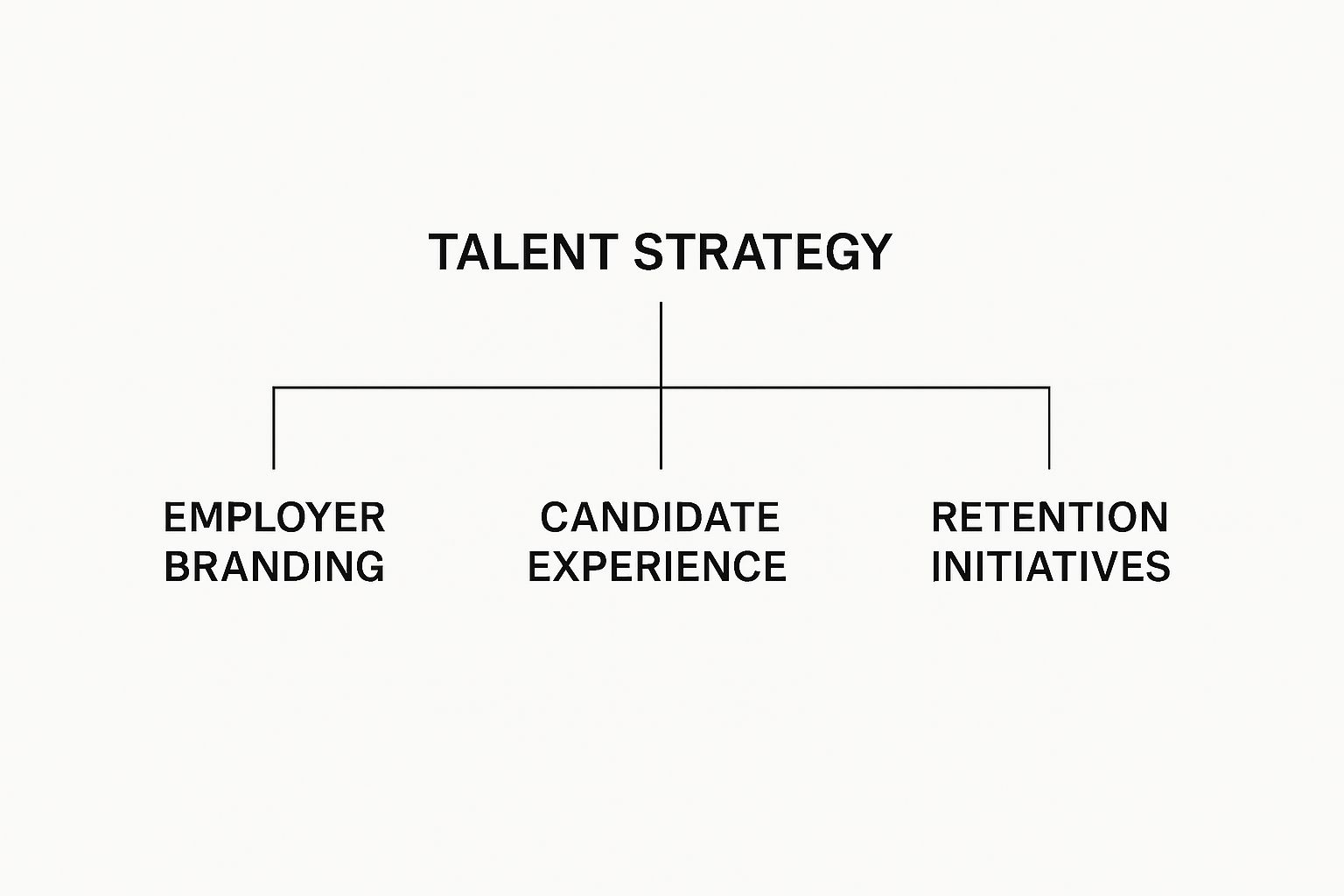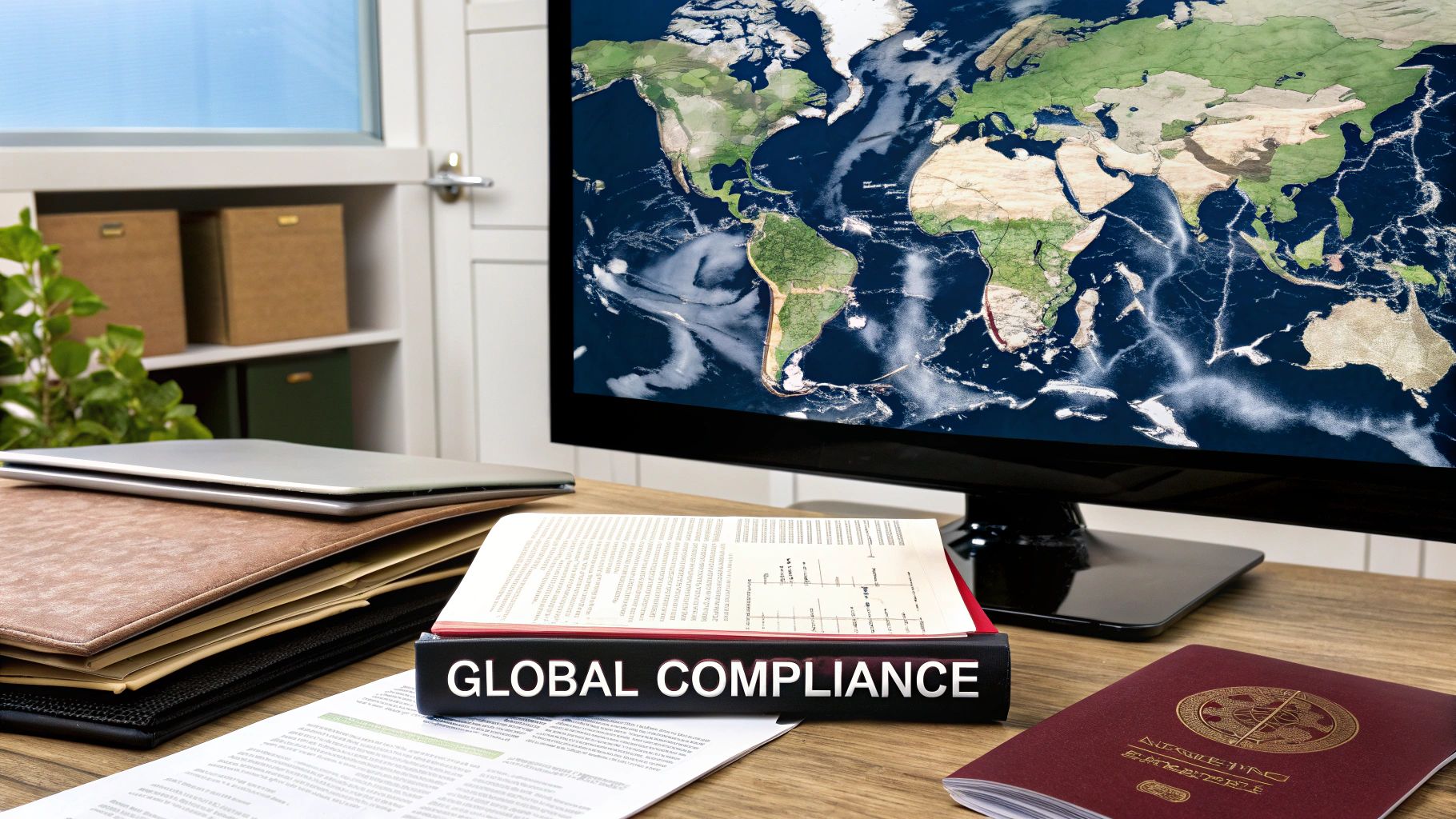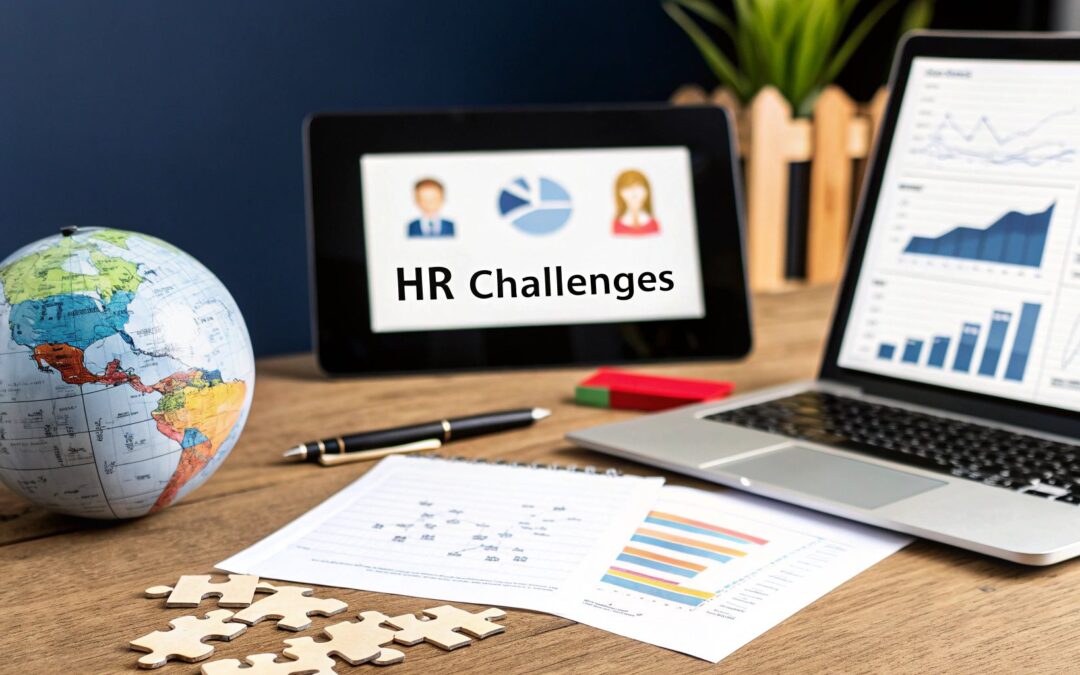Let’s be real: Human Resources isn’t just about payroll and paperwork anymore. The job has evolved into a high-stakes game of strategic talent acquisition, keeping up with dizzying tech changes, and untangling a web of global compliance rules. Today’s HR pros are in the trenches, acting as essential partners in a company’s success.
The Evolving Role of Modern Human Resources

The HR department has come a long way. What was once seen as an administrative, back-office function is now a strategic powerhouse critical for growth. This shift puts HR leaders on the front lines, grappling with pressures that ripple through the entire organization.
Business today is all about constant change. We’re dealing with economic curveballs, fierce competition for good people, and employee expectations that seem to shift overnight. HR is no longer just reacting; it’s expected to see what’s coming and build a team that can handle it.
Key Pressures Shaping HR Today
Getting a handle on these modern HR challenges is make-or-break. It’s a delicate balancing act between old-school responsibilities and new strategic demands. The biggest hurdles right now include:
- The War for Talent: Finding and keeping top performers isn’t just an HR task—it’s a core business objective.
- Strategic Misalignment: It’s one thing to say HR should be strategic, but it’s another to actually have a solid plan to get it there.
- Technological Integration: New tech is coming at us fast. HR has to weave in new tools without overwhelming employees. You can see a great example of this in how low-code and no-code AI platforms are changing business.
- Global Complexity: Managing remote or distributed teams brings a whole new level of compliance headaches and cultural puzzles.
This guide is designed to break down these core issues. We’ll give you a clear roadmap to turn each obstacle into a chance to build a stronger, more successful organization.
Ultimately, solving these problems isn’t just for the HR department to worry about. It’s fundamental to hitting long-term business goals, from boosting profits to creating a culture where great ideas can flourish. Let’s dive into each of these areas and explore some practical ways to navigate them.
Winning the Modern War for Talent
Let’s be honest: finding and keeping great people has become one of the toughest parts of running a business. In a market this competitive, with skills gaps widening every day, the old playbook for recruiting just doesn’t work anymore. Winning today is about two things: attracting the right talent in the first place, and then giving them every reason to stick around.
Think of it like this. Old-school recruiting was like casting a huge net and hoping you caught a few good fish. Modern talent acquisition is more like crafting the perfect bait for a specific type of fish you want to catch—it attracts the exact talent you need and doesn’t waste time on the rest. It all starts with your employer brand.
Crafting a Magnetic Employer Brand
Your employer brand is simply your reputation as a place to work. It’s the sum of everything from your company’s core mission to the candid reviews your employees leave on Glassdoor. It’s what potential candidates feel about you long before they ever see a job posting.
A weak brand means you’re constantly fighting an uphill battle, working twice as hard to attract candidates who might not even be the right fit. A great brand, on the other hand, does the recruiting for you. It builds a natural pipeline of people who are already bought into what you’re doing. This isn’t about marketing fluff; it’s about telling a true story about your culture and showing up with it consistently, everywhere from your careers page to social media.
This diagram breaks down how a solid talent strategy is built on three core, interconnected pillars.

As you can see, it’s a balancing act. You need to pull in new talent while making sure your current team feels valued and motivated.
The Retention Revolution
Getting someone to sign an offer letter is just the first step. The real challenge—and where most companies stumble—is keeping them. High turnover is a silent killer. It doesn’t just cost money to rehire; it drains your team of deep-seated knowledge and chips away at morale. Forget pizza parties; real retention is about understanding what truly makes employees loyal.
Burnout and disengagement are reaching epidemic levels. Recent data shows that around two-thirds of employees feel burned out, and roughly a third are unhappy with their jobs. This fire is fueled by major talent shortages, with 58% of Learning and Development leaders calling out skill gaps as a top concern. The cost is staggering: low employee engagement sucks an estimated $8.9 trillion out of the global economy each year. You can explore more research on these global HR challenges to grasp the full scale of the problem.
The key to retention isn’t just about preventing people from leaving; it’s about creating an environment where they genuinely want to stay and grow.
This means getting proactive. It’s about creating meaningful work, showing people a clear path for advancement, and building a culture that genuinely supports them. To truly win the war for talent, you have to invest just as much in the team you have as you do in finding your next superstar.
Bridging the HR Strategy and Execution Gap
Most leaders will tell you they want HR to be a strategic partner, a true force in shaping the company’s future. But if you talk to the HR teams themselves, you often hear a different story—one filled with the daily grind of putting out administrative fires, leaving almost no time for big-picture thinking. It’s a frustrating disconnect and one of the most common challenges in human resources today.
This isn’t just a hunch; the data paints a clear picture. There’s a huge gap between knowing a change is needed and actually being ready to make it happen. A striking 87% of HR leaders see the need to transform their function into a strategic powerhouse, yet only 27% have a concrete plan to get there. As you can discover more insights about HR’s strategic shift on blog.workday.com, this highlights some deep-rooted barriers keeping HR stuck in a support role.
The problem is often a vicious cycle. HR teams are so bogged down with payroll, benefits, and compliance that they have no mental space left for critical initiatives like workforce planning or developing the next generation of leaders. Throw in some clunky, outdated technology and a tight budget, and it’s easy to see how the function gets stuck in an operational rut.
From Cost Center to Strategic Powerhouse
Breaking free requires a conscious shift, both in mindset and in practice. HR has to stop being seen as just a “cost center”—a department that only spends money—and reposition itself as a strategic asset that actually drives business value. The key is learning to draw a straight line from HR activities to company-wide results.
For example, instead of just reporting that turnover is up, a strategic HR team digs into the data. They figure out why top performers are leaving a specific department and then propose a targeted plan to keep them. This proactive approach turns HR data from a simple report card into a powerful tool for improving the business. If you’re looking to make this shift, see how your team can start using data-driven decision-making in HR.
The goal is to move from “what happened?” to “what can we make happen?” This requires HR leaders to think like business leaders, fluent in the language of KPIs, revenue, and market share.
Bridging this strategy-execution gap means HR professionals have to get serious about building new skills. They need to get comfortable with workforce analytics, know how to connect talent programs to financial goals, and be able to clearly communicate their value to the C-suite. It’s all about showing, not just telling, how investing in people directly impacts the bottom line.
HR teams often find themselves caught between their strategic aspirations and the relentless demands of daily operations. The table below outlines some of the most common barriers that widen this gap and offers practical solutions to help HR leaders build that crucial bridge.
Bridging the HR Strategy-Execution Gap
| Challenge Area | Description of Barrier | Strategic Solution |
|---|---|---|
| Operational Overload | HR teams are consumed by administrative tasks like payroll and benefits, leaving no time for strategic planning. | Invest in HR technology (HRIS, automation tools) to automate routine tasks, freeing up the team for higher-value work. |
| Lack of Data Fluency | HR struggles to translate people data into business insights, making it difficult to prove the ROI of their initiatives. | Develop analytics capabilities. Train the team to interpret workforce data and link metrics like engagement to business outcomes. |
| Misalignment with Business | HR initiatives are created in a vacuum, disconnected from the company’s core financial and operational objectives. | Embed HR business partners within departments. Ensure every HR program is explicitly tied to a specific business goal. |
| Reactive Mindset | The department operates in a constant state of reaction, addressing problems as they arise rather than anticipating future needs. | Shift to proactive workforce planning. Use predictive analytics to forecast talent needs, skill gaps, and potential turnover risks. |
By systematically addressing these barriers, HR can finally move from a support function to a central driver of organizational strategy and success.
Key Steps to Elevate HR’s Role
Becoming a true strategic partner doesn’t happen overnight. It’s a journey, but one that starts with a few deliberate actions:
- Master the Data: Use analytics to get a real grip on workforce trends, predict what talent you’ll need tomorrow, and actually measure the return on your HR programs.
- Align with Business Goals: Before launching any new initiative, from hiring to training, ask: “Which specific company objective does this support?” If there’s no clear answer, rethink it.
- Develop Business Acumen: You have to understand how the company makes money. Get familiar with the financial model, who the competition is, and the operational headaches other departments face.
- Invest in HR Technology: Modern tools are your best friend. They can automate the soul-crushing administrative work, which is the single biggest step to freeing up your team for the work that matters.
Taking these steps is how HR breaks free from its administrative chains and earns its seat at the table as a vital contributor to the company’s success.
Navigating Compliance in a Borderless Workforce

The modern office isn’t a single building anymore. As remote and hybrid work becomes the norm, teams are spread across cities, states, and even continents. This has opened up a world of possibilities for finding top talent, but it’s also thrown a massive wrench into the works: international compliance.
Hiring someone in another country involves far more than just sending a laptop and an offer letter. You’re stepping into a completely different ecosystem of labor laws, tax codes, mandatory benefits, and deeply ingrained cultural norms. What’s considered standard procedure in your home country could be a serious legal misstep somewhere else.
This creates a high-stakes juggling act for HR teams. A single mistake, even an honest one, can snowball into crippling fines, lengthy legal battles, and a black eye on your company’s reputation. It’s not just a paperwork problem; it’s a major business risk that needs to be handled with extreme care.
The Scale of Global Compliance Hurdles
Just how big of a deal is this? A staggering 86% of HR leaders say that keeping up with international labor laws is their single biggest hurdle when managing teams in different countries.
The pressure is intense. In fact, 51% of HR professionals now bring in outside experts just to help them navigate new markets and stay compliant. To stay ahead of the curve, 95% of these leaders are turning to AI tools to research employment laws and benchmark talent.
This complexity bleeds into everyday tasks, too. For example, accurate absence tracking for HR compliance isn’t just about knowing who’s out of office. It’s a legal necessity. Each country has its own specific rules for sick leave, holidays, and paid time off, and one slip-up in tracking can land you in hot water.
Using Technology to Simplify Complexity
Thankfully, HR teams don’t have to go it alone. Technology has become an essential partner in managing global operations and keeping compliance risks in check. Specialized platforms and AI-powered tools are fundamentally changing how companies handle their international workforce.
The right technology turns the overwhelming complexity of global compliance into a manageable, data-driven process, allowing HR to focus on people instead of paperwork.
These tools are designed to automate critical processes and deliver real-time information when you need it most. Here’s a quick look at how they’re making a real difference:
- Automated Legal Research: Imagine an AI that constantly scans for labor law changes in every country you operate in. These tools send instant alerts, so you’re never caught off guard by a new regulation.
- Streamlined Global Payroll: Specialized platforms can handle payroll in multiple currencies, automatically calculating taxes and social contributions based on local rules. No more manual conversions or guesswork.
- Standardized Benefits Administration: Technology helps you build and manage benefits packages that are both competitive in the local market and fully compliant with that country’s legal requirements.
By putting these solutions to work, HR can confidently build and support a borderless workforce. What was once a daunting compliance nightmare can become a powerful strategic advantage for global growth.
4. Embracing a Human-Centric Tech Transformation

Technology in HR can feel like a double-edged sword. On one side, you have AI, slick analytics platforms, and modern HRIS systems that promise to make everything faster and smarter. But on the other, a clumsy rollout can create more chaos than it solves. This is one of the most delicate challenges of human resources management today: how do you adopt new tech without losing the human touch?
Think of it like getting a powerful new tool for a workshop. In the hands of a skilled carpenter with a plan, it can create beautiful furniture. But without proper training or a clear purpose, it’s just going to make a mess. A rushed implementation can leave your team frustrated, confused, and even less productive than before.
The key is to remember that technology should always serve people, not the other way around. Every decision you make—from which software to buy to how you introduce it to the team—has to be filtered through the employee lens. Does this tool actually simplify their work? Will it make their life easier? If the answer isn’t a clear “yes,” it’s probably the wrong tool.
Choosing the Right Tools for Your People
Picking the right HR technology isn’t about chasing the shiniest new object. It’s about solving real problems for your people. Before you even start looking at demos, you have to get a clear picture of your organization’s specific pain points.
A successful digital shift in HR is less about the software and more about the strategy. It’s about building a tech stack that empowers your team, automates the tedious stuff, and frees up your HR professionals to focus on what they do best—working with people.
So, how do you get there? It starts with a few foundational steps:
- Identify Core Problems: Don’t start with solutions. Start by asking your team what their biggest administrative headaches are. Is it the clunky expense reporting? The confusing benefits portal? Find the friction first.
- Prioritize Employee Experience: Frame every potential feature in terms of employee benefit. Will this new system make requesting time off a one-click process? Will it provide clearer, more consistent performance feedback?
- Ensure Seamless Integration: A shiny new tool that doesn’t talk to your existing systems just creates more manual data entry, completely defeating the purpose. This is a core principle of effective business process automation.
Navigating the Ethical Maze of HR Tech
Beyond just making things work, modern HR tech brings some complex ethical questions to the table. Using AI in hiring, for example, comes with the very real risk of algorithmic bias, where a system can unintentionally learn to favor certain demographics over others.
Then there’s data privacy. Your HR systems hold an incredible amount of sensitive employee information, and protecting it isn’t just a good idea—it’s a fundamental responsibility.
Building a tech strategy that truly empowers people means facing these issues head-on. It requires clear, transparent policies about how employee data is collected and used. It means regularly auditing your AI tools to check for bias. Most importantly, it means committing to using technology to assist human judgment, not replace it entirely. This thoughtful approach is the only way to ensure your tech transformation helps build a workplace that’s not only efficient but also fair and trustworthy.
Building a Resilient and Future-Ready Workforce
Tackling today’s HR challenges isn’t a game of whack-a-mole. You can’t just react to problems as they pop up. The real goal is to build a workforce that’s not just resilient but truly ready for whatever comes next—an organization that doesn’t just weather change but uses it as a springboard for growth.
This means you have to knit together all the strategies we’ve been talking about into one seamless whole. Picture it like building a bridge. Strategic talent management creates the rock-solid pillars, making sure you have the right people in place. Smart, people-focused technology acts as the support cables, handling the grunt work and giving you the data to make confident moves. And a firm grip on global compliance is the sturdy decking that lets you expand without fear.
The Pillars of Workforce Resilience
Putting this kind of organization together comes down to a few core efforts. These aren’t just items on an HR to-do list; they are critical business priorities that future-proof your company.
- Strategic Talent Development: Stop thinking about just filling seats. You need to build clear career pathways, actively upskill your existing team for tomorrow’s challenges, and create a culture where learning never stops.
- Agile Technology Adoption: Don’t just buy the latest shiny object. Pick tools that actually help your people. Your priority should be tech that makes work simpler, offers real insights, and improves the employee experience from top to bottom.
- A People-First Culture: When it comes right down to it, resilience is human. You have to build a culture of trust and transparency where people feel psychologically safe and genuinely supported, especially when things get tough.
Recruiting is just the beginning. To truly build a future-ready team, you need to implement robust talent management best practices.
The future of HR isn’t about having a crystal ball. It’s about building an organization so agile and a team so engaged that you’re ready for any future that arrives.
When you take this approach, HR stops being a reactive support department and becomes a strategic engine for the entire company. By leading the way in building a resilient workforce, you’re not just putting out today’s fires—you’re creating a powerful competitive advantage that will fuel your success for years to come.
Common Questions About HR Challenges
Let’s be honest, navigating the world of HR today can feel like trying to solve a puzzle with constantly changing pieces. Here are some straightforward answers to the questions that come up most often when we talk about human resources challenges.
What Is the Single Biggest HR Challenge Today?
If you ask ten different HR leaders, you might get ten different answers, but they’ll all likely circle back to one central theme: talent management. It’s a two-sided coin. On one side, you have the intense competition to attract great people. On the other, you have the equally difficult task of keeping them engaged, motivated, and happy.
The numbers don’t lie. High turnover costs are a huge drain on resources, and skill gaps can bring productivity to a grinding halt. That’s why talent is front and center for almost every company. It’s the root system from which so many other HR challenges grow.
At its core, talent management is about seeing people as the engine of the business, not just another line item. If you can’t attract or keep the right people, your ability to innovate and grow stalls out.
How Can Technology Solve Common HR Challenges?
Think of technology, especially a good HRIS or AI-powered tool, as your best assistant. It takes on the tedious, administrative work—the paperwork, the scheduling, the repetitive tasks—that eats up so much of an HR pro’s day. This isn’t about replacing people; it’s about freeing them up to focus on the human side of human resources.
Beyond automation, these systems give you incredible data to make smarter decisions. You can see real trends and insights in areas like:
- Recruitment: Pinpoint the right candidates faster and more accurately.
- Performance Management: Track employee progress and offer objective, helpful feedback.
- Workforce Planning: Look ahead and predict what skills you’ll need next year, not just next week.
And for companies with a global footprint, technology is a lifesaver. It helps you navigate the maze of international labor laws, turning a huge compliance headache into something you can actually manage.
Why Is Becoming a Strategic Partner So Difficult for HR?
It’s a tough nut to crack, and it usually comes down to a mix of old habits and new pressures. For decades, HR was seen as the department that handled payroll, policies, and problems—an administrative function, plain and simple. That “personnel office” stereotype is a hard one to break, both for other leaders and sometimes even within HR itself.
The day-to-day reality doesn’t help. HR teams are often so busy putting out fires and dealing with immediate operational needs that there’s no time to think bigger. To really earn a seat at the strategy table, HR leaders have to show their value with data. They need to connect their work directly to business goals and shift from simply reacting to problems to proactively shaping the workforce for the future.
At Zilo AI, we get it. We know these challenges are real because we help companies solve them every day. We provide the skilled people and high-quality data services you need to build a team that’s ready for anything. Learn how our manpower solutions can help you overcome your biggest HR hurdles.

